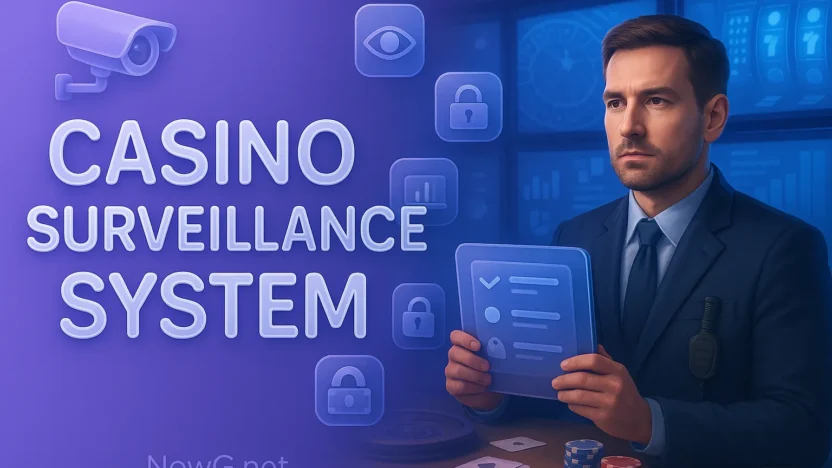Last Updated on August 24, 2025 by Caesar Fikson
Casinos don’t run on spectacle; they run on proof. When disputes arise, when a dealer mispays, when a self-excluded patron tests your front door, the only thing that matters is whether you can retrieve the right angle, at the right second, with an unimpeachable chain-of-custody. If you can’t, you don’t have a surveillance program—you have expensive wallpaper.
This deep-dive is your field manual: architecture that works on real floors, features that matter (and the ones that don’t), how leading systems compare, and the operational playbooks that turn cameras into evidence. No external links in the narrative; the only URLs appear in the software table for your RFP convenience.
Why casino surveillance is its own category
Casinos combine dense crowds, fast cash movement, regulated activities, and sophisticated adversaries. That mix creates requirements you won’t find in typical corporate CCTV:
- Coverage density: tables, slots, entrances, cage/count, drop/soft count, back-of-house, parking, docks—each with regulatory placement and quality expectations.
- Low-latency retrieval: operators must pivot between cameras, time ranges, and PTZ presets in seconds—not minutes.
- Evidence lifecycle: hashing, export control, chain-of-custody logs, and player playback that works in court.
- Interoperability: VMS needs clean hooks into POS, access control, table-game systems, slot-floor data, and alarm servers.
- Automation (done right): analytics that reduce workload (not create noise), table-game automation that captures per-hand truth, and facial recognition (FR) only where lawful and governed.
The capability pillars (build your RFP around these)
- See the critical event
- Multisensor panoramic for wide coverage, paired PTZs for detail on kinetic games (roulette, craps).
- Correct lensing, angles, and frame rates to preserve motion detail and chip values.
- Find it fast
- VMS with timeline scrubbing that doesn’t stutter, map layouts, camera tours, and search by attributes (clothing color, bag, “red hat”) where supported.
- Case management that packages multi-camera evidence with hashes and an embedded player.
- Prove it happened
- Immutable audit logs, export hashing, role-based access, dual-control for sensitive reviews, and retention policies mapped to regulation.
- Correlate events
- POS voids/refunds, access door opens, slot exceptions, table-game anomalies—pulled into the same pane and linked to video on the exact timestamps.
- Survive failures
- Recorder failover, storage redundancy, switch diversity, and playbooked disaster recovery (DR). No single point of truth.
An architecture blueprint that survives real weekends
Cameras:
- Pits: multidirectional/panoramic heads for overview; dedicated PTZs above kinetic tables; fixed 4K over cash trays.
- Slots: corridor-view coverage across banks; consistent mounting heights and overlaps to avoid blind seams.
- Cage, vault, count rooms: high-resolution fixed with overlapping fields of view; dual coverage on every cash surface; consider audio where permitted and useful.
- Entrances/queues: frontal identification zones (if lawful); people counting for staffing and egress analysis.
- Back-of-house: all access-controlled doors, sensitive corridors, and the surveillance room ingress/egress.
- Perimeter/parking: low-light models with good WDR; if you deploy LPR, treat plate data as controlled information with retention rules.
Frame rates & encoding:
- Tables and fast action: 20–30 fps (or higher for roulette/craps); H.265/Smart codecs tuned for motion.
- Slots and corridors: 10–15 fps is often adequate; tune GOP to your VMS best practices.
- Don’t starve bitrate on scenes with fine detail (chips, cards, cash). Compression artifacts lose cases.
VMS core:
- Must support thousands of channels, instant search, case packaging, maps, failover recording, hashing, operator permissions, and API integrations (POS, access control, table/slot systems, alarm servers).
- Validate joystick support, keyboard shortcuts, and multi-monitor ergonomics for your operators.
Storage:
- Compute with peak bitrates (weekend nights), not averages.
- Size ingest for required retention by area/event.
- Consider scale-out or HCI stacks validated with your chosen VMS for consistent ingest and smooth playback.
- Archive tiers (fast → cold) only if retrieval SLAs stay <60 seconds to “first frame.”
Network & cyber:
- Segmented video VLANs, management interfaces off-limits to office networks, MFA for admin, signed firmware, and patch cadence.
- Treat camera passwords and certificates like cash equivalents. You are a target.
Evidence lifecycle: from incident to courtroom
- Triage: operator marks time range, creates case, bookmarks cameras/angles.
- Collection: export original streams + secure player, generate SHA-256/512 hashes, log accessor and purpose (case ID).
- Preservation: store on write-once or versioned evidence NAS with role-based access; mirror to off-site DR per policy.
- Disclosure: redact non-relevant faces/PII where required; keep an unredacted master under stricter controls.
- Audit: ensure you can show who accessed what, when, and why—without gaps.
Analytics that actually help (and where they don’t)
Video content analytics (VCA):
- Good for post-event acceleration (searching hours in minutes), basic occupancy/crowding, line crossing, loitering.
- Great when you can filter by attributes (shirt color, bag, vehicle type) to find “the person with a red jacket.”
- Don’t rely on generic motion alarms in busy pits; they’ll drown your team. Tune zones and confidence thresholds.
Facial recognition (FR):
- Use cases: self-exclusion, trespass, known advantage play, and VIP flows (with policy).
- Guardrails: legal basis, consent/exemptions where required, watchlist governance (add/remove), bias testing, audit logs, and retention hygiene.
- Place capture zones with good lighting and frontal angles; document the DPI you can guarantee.
Table-game automation:
- Video-based systems (computer vision) can detect game events (first bet, cards out, payout), pace, and anomalies.
- RFID hybrids (chips + table antennas) capture wagers, splits/doubles, counterfeit chips, and past-posting attempts.
- Strategic outcomes: fewer disputes, hands-per-hour up, cleaner dealer coaching, and surveillance empowered with machine-captured ground truth (not just “what it looked like”).
Integration fabric: the single-pane truth
You’ll get outsized value when your VMS is correlated with:
- POS: voids, no-sales, refunds, comp transactions → instant video recall.
- Access control: door opens/forced entries → camera pops; anti-passback violations.
- Slot management: hopper fills, door opens, tilt events → synchronized video.
- Table systems: per-hand metadata, dealer changes, chip activity → anomaly surfaces for review.
- Alarms: motion/tamper, analytics alerts, and third-party intrusion sensors → one incident timeline.
Ask vendors to demo real integrations with your actual event types, not just “we have an API.”
Operations: staffing, SOPs, and control room ergonomics
Staffing:
- Split roles between live monitoring (floor/pit coverage, alarms) and investigations (pulling cases, packaging exports).
- Cross-train with gaming ops and cage/count teams; a shared vocabulary cuts incident times.
SOPs:
- Camera failure response (who, within what SLA).
- Table/pit action plan (roulette mispay, blackjack past-posting, marker disputes).
- Self-exclusion/trespass hit response with liaison to security/hosts.
Ergonomics:
- Multi-monitor consoles with consistent layouts by zone (pits, slots, cage).
- Joysticks for PTZ control; avoid “mouse-only” rooms for kinetic tables.
- Quiet HVAC, lighting designed to reduce eye strain—operator fatigue is a security risk.
Implementation roadmap (clean and realistic)
- Discovery (2–4 weeks): camera audit, coverage gaps, regulatory map by area, integration inventory.
- Design (3–6 weeks): lensing, mount points, network drawings, recorder/storage design, failover paths, retention tiers.
- Build (6–12 weeks): racks, switching, storage, camera install, VMS config, map layouts, user roles, analytics baselines.
- Pilot (2–3 weeks): pick one pit, one slot bank, cage, and an entrance for end-to-end validation.
- Cutover (1–2 weeks): dual record (old/new) if possible; switch zones in blocks; keep a “hot” legacy recorder for 30 days.
- Hypercare (2–4 weeks): operator coaching, tuning alerts, acceptance tests, and documentation handoff.
Retention and policy (don’t wing it)
- Map minimum retention by area (tables, cage, count rooms, entrances) and by event type (incidents, jackpots, investigations).
- Use legal holds to lift clips out of aging policies without losing hashes/audit.
- Review policy quarterly with surveillance + compliance + legal.
KPIs that matter
- Time to first frame (operator search → playback).
- Export cycle time (incident → hashed package with player).
- Hands per hour (before/after table automation).
- Dispute reversal rate (percentage resolved on first review).
- Camera uptime and mean time to repair.
- False positive rate for analytics and FR.
Pitfalls and countermeasures
- Under-spec’d storage: size for peaks; recorders should ingest without frame drops during sellout weekends.
- “Any-any” network rules: lock down camera subnets; monitor for rogue discovery attempts.
- Operator overload: fewer, smarter views; scene-based layouts beat 64-tile walls nobody can read.
- Integration theater: a swagger API is not an integration. Demand live, end-to-end demos with your events.
- Unclear facial recognition policy: if you deploy FR, create a policy with governance, redress, and audits before you turn it on.
Sample coverage plan for a mid-size property
- 10–12 pits: multisensor overviews per pit, 1 PTZ per kinetic game, fixed 4K over high-value table cash trays; 25–30 fps.
- Slot floor (~1,000 machines): corridor-view across banks, perpendicular coverage at cage-facing aisles; 12–15 fps.
- Cage/soft count/vault: dual coverage per surface; overlapping views; consider audio where allowed; 20–30 fps.
- Front-of-house entrances: frontal capture zones; people counting; 15–20 fps.
- Back-of-house: all access-controlled doors, server rooms, surveillance ingress; 10–15 fps.
- Perimeter/parking/docks: low-light, WDR; LPR if permitted; 10–15 fps.
The market landscape (systems and what they’re built to do)
| Vendor / System | Category | Core Strengths | Typical Casino Uses | Notable Capabilities | Official Site |
|---|---|---|---|---|---|
| Genetec Security Center (Omnicast) | VMS / Unified Platform | Large-scale unification (video, access, ALPR), operator ergonomics | Multi-property estates, regulated markets | Federation, case mgmt, hashing, broad device support | https://www.genetec.com |
| Milestone XProtect | VMS | Open ecosystem, rapid investigate, rich plug-ins | Resorts needing analytics variety and verified storage | Smart Search, map views, failover, strong SDK | https://www.milestonesys.com |
| Avigilon Unity (formerly ACC) | VMS + Cameras | Low-light cameras, AI search, end-to-end simplicity | Table/slot detail, fast attribute search | Appearance search, multi-sensor synergy | https://www.avigilon.com |
| Synectics Synergy | Command & Control (Gaming-centric) | Correlates alarms, video, POS/gaming data | Control rooms with incident workflows | Casino-built playbooks, advanced search | https://www.synecticsglobal.com |
| Pelco VideoXpert | VMS | Operator-friendly UI, migration from legacy | Property refresh (Endura → VideoXpert) | Case packaging, multi-monitor ergonomics | https://www.pelco.com |
| Qognify VisionHub | VMS + Situational Awareness | Unified ops dashboards + video | Properties needing cross-system visibility | Event correlation, enterprise management | https://www.qognify.com |
| Wavestore | VMS | Fast search over large archives, integrity checks | Dispute-heavy environments | Evidence hashing, scalable storage handling | https://www.wavestore.com |
| March Networks | VMS + Appliances | Centralized management, reliability | Mixed hospitality/gaming estates | Health monitoring, enterprise management | https://www.marchnetworks.com |
| BriefCam | Video Analytics | Post-event acceleration, real-time alerting | Investigations, ops intelligence | Video synopsis, attribute filtering | https://www.briefcam.com |
| i-PRO Active Guard | Edge/Server Analytics | Attribute search with camera AI | People/vehicle attribute search | Plug-ins for major VMS platforms | https://i-pro.com |
| Dallmeier CAT | Table Automation | Per-hand metadata, pace/anomaly detection | Baccarat/blackjack automation | Video-based game event capture | https://www.dallmeier.com |
| ANGEL (Angel Eye / Smart Float) | Smart Table (RFID + AI) | Chip/wager tracking, counterfeit/past-post detection | RFID-enabled tables & float | Real-time bet validation | https://www.angelplayingcards.com |
| WDTS Perfect Pay | Smart Table (RFID) | Edge-of-spot bet capture, payout accuracy | Blackjack/baccarat with RFID chips | Per-position wager tracking | https://www.wdtablesystems.com |
| NEC / Oosto / Cognitec / eConnect | Facial Recognition Suites | POI/self-exclusion, VIP workflows (policy-led) | Entrances, cage, high-risk zones | Watchlist mgmt, VMS integrations | https://www.nec.com / https://www.oosto.com / https://www.cognitec.com / https://www.econnectglobal.com |
| Axis / Hanwha / i-PRO / Avigilon | Cameras (Multisensor/PTZ/Low-light) | Coverage density + detail, AI at edge | Pits, slots, entrances, perimeters | Multidirectional heads, WDR, low-light | https://www.axis.com / https://hanwhavisionamerica.com / https://i-pro.com / https://www.avigilon.com |
(You can add or prune vendors to match your jurisdiction, preferred integrators, and budget bands.)
Side-by-side capability comparison (what matters most to operators)
| Capability | Why It Matters | VMS Priority | Analytics Priority | Table-Tech Priority |
|---|---|---|---|---|
| Timeline speed | Operators need “first frame” < 5–10 seconds | ★★★★★ | ★★★☆☆ | ★☆☆☆☆ |
| Case packaging + hashing | Courtroom credibility | ★★★★★ | ★★★☆☆ | ★★☆☆☆ |
| Failover recording | No dropped frames during outages | ★★★★★ | ★★★☆☆ | ★★☆☆☆ |
| Map & PTZ orchestration | Pit tracking under pressure | ★★★★☆ | ★★☆☆☆ | ★☆☆☆☆ |
| Attribute search (red jacket, backpack) | Faster investigations | ★★★★☆ | ★★★★★ | ★☆☆☆☆ |
| POS/access/table integration | Correlated truth, not vibes | ★★★★★ | ★★★★☆ | ★★★★☆ |
| Per-hand event capture | Stops leakage and mispays | ★☆☆☆☆ | ★★☆☆☆ | ★★★★★ |
| Counterfeit/past-post detection | Protects game integrity | ★☆☆☆☆ | ★★☆☆☆ | ★★★★★ |
| Bias/FR governance | Legal + reputational risk | ★★★★☆ | ★★★★☆ | ★☆☆☆☆ |
RFP questions that separate contenders from pretenders
- Operator speed test: “Find a red-hat patron crossing three cameras in the last 30 minutes and export a hashed package with a player—60 seconds on the clock.”
- Failover demo: “Kill a recorder mid-ingest; show zero frame loss and seamless playback.”
- Retention reality: “Prove retention by area (tables vs. entrances vs. cage), including event-based legal holds.”
- Integration, live: “Show POS void → instant video, door forced → camera pop, and a table anomaly → case ticket.”
- Analytics signal/noise: “Demonstrate a calibrated alert that doesn’t flood operators on weekends.”
- FR governance (if applicable): “Show watchlist lifecycle, audit, and redress; demonstrate privacy-safe redaction for disclosures.”
- Cyber posture: “SSO/MFA, signed firmware, least privilege, and hardening checklist—walk us through.”
Budget and TCO (design for what you can maintain)
- CapEx: cameras, mounts, cabling, racks, servers/storage, consoles.
- OpEx: licenses, support plans, storage expansions, cyber hygiene (patching, certs), analytics compute.
- Integration: POS/access/table connectors and ongoing version sync.
- People: training, SOP maintenance, and quarterly drills.
A “cheaper” stack that operators can’t drive quickly will cost more in disputes, shrink, and fines.
Acceptance testing (don’t sign off without this)
- Coverage audit: each regulated area has the mandated angles and quality (printed checklist per camera).
- Stress test: peak-floor simulated load (all pits busy) with concurrent exports and live PTZ use.
- DR drill: recorder loss, switch failover, and storage path outage.
- Case challenge: a blind incident seeded by the vendor—your team must find, package, and hash in <10 minutes.
- Documentation: as-built diagrams, IP/asset list, firmware versions, retention map, admin runbooks.
Practical playbooks you can run next week
“Past-posting” playbook (roulette/blackjack)
- Deploy fixed high-res above cash trays and betting spots; PTZ preset on ball release/spin.
- If using table automation, enable first-bet and end-of-round event markers; auto-flag out-of-sequence wagers.
- Export with paired angles (overview + detail) and include table metadata when available.
Self-exclusion/trespass
- Define capture zones with consistent frontal lighting at entrances.
- Watchlist managed by policy owner, not operators; auto-log decisions and false positives for review.
- On hits: notify security and hosts; escalate per SOP; record response times.
Cage discrepancy
- Dual coverage of each money surface; require bookmarks on every variance.
- POS/access events attached to the case file; include count-room reconciliation.
What to choose, when (a candid rubric)
- You want unified security (video + access) across a big estate with clean operator tooling → a mature, unified platform VMS.
- You want open VMS with tons of third-party analytics and verified storage recipes → a leading open-platform VMS.
- You want end-to-end cameras + VMS with very fast attribute search → a camera-vendor suite with strong AI search.
- You want casino-native incident management with deep data correlation → a gaming-centric command-and-control platform.
- You need post-event acceleration at scale → a specialized video analytics layer.
- You want per-hand truth at tables → table automation (video-based) or RFID hybrids, or both.
- You will enforce self-exclusion/trespass → an FR suite with auditable governance, or skip it until your policy is ready.
Closing perspective
The “best” casino surveillance stack isn’t a logo—it’s a system: coverage that never misses, retrieval that never sputters, storage that never coughs, analytics that reduce work, and table-tech that turns arguments into data. Build for operator speed and evidentiary strength first. Validate under peak load. Lock cyber down. And measure what matters: time to first frame, export cycle time, hands per hour, dispute reversals.
When you can answer “show me” in under a minute, reliably, you’ll feel the program shift—from reactive to resilient. That’s when surveillance stops being wallpaper and starts being an edge.




